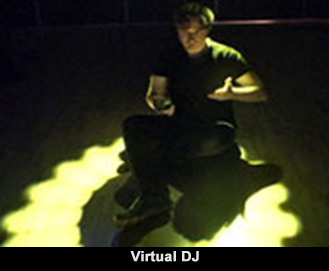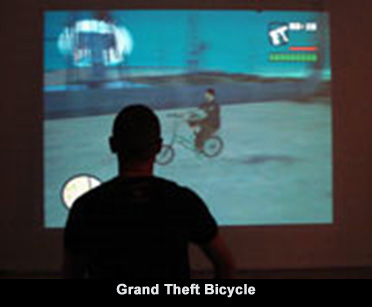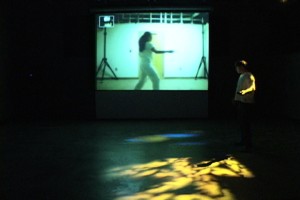

Jeremy Hight: Who are some of your influences?
Steve Gibson: For long-term influences I can start by describing things that made a deep impression on me when I was younger. The first would be Kubrick's 2001, which my father took me to when I was six or seven. More properly the atmosphere created by Ligeti's music in combination with the visual world made a deep and lasting impression on my brain. Of course I knew nothing about Ligeti at that time, but he remains my favorite composer of the late modern era, and Kubrick is one of my two or three favorite filmmakers. Both have a sense of space and grandeur that continues to impress me and to influence the way I think about sound and visuals.
On the music side I heard Kraftwerk's Autobahn when I was about thirteen. I had no idea where the sounds came from, but they grabbed in a way that nothing else did at the time. At this stage I then devoured as much electronic music from the period that I could. Virgin-era Tangerine Dream would be another key influence, especially their longer works such as Ricochet and Phaedra. I love sense of space of those works and also the strange emotional richness of them. The first Faust LP also was an amazing thing, so strange and otherworldly and at the same time aggressive and at times brutal. Also Can's Damo Suzuki-era LPs singularly proved to me that one could be both experimental and funky at the same time.
For electronic arts I was interested in Laurie Anderson for quite some time. For me her United States Live performance was the benchmark for a true Gesamstkunstwerk of the electronic age. I continue to be impressed by the conceptual unity of that work, and how music, poetry and film were combined in a way that had genuine purpose and intent. In a similar way I have always been impressed by the work of Cabaret Voltaire, though for their recorded audio-visual work rather than for their performances (I have never seen them live). Sensoria remains for me the most impressive music video I have ever seen, particularly as the edit is so tight and done without any assistance from a computer.
For interactivity Myron Krueger's Videoplace is key. It's simple and direct mode of interaction is to me a pure example of a naturalistic interface strategy that I have tried as best to emulate in my own work. Other pieces that fit into this vein would be Rafael Lozano-Hemmer's Body Movies and Perry Hoberman's Bar Code Hotel.
More currently I am really into DJing and VJing using my alter-ego DJ Nord. My recent favourite music artists would be The Field, Trentemøller, Crystal Castles, The Knife and Trust. I also am really impressed by the visual music of Plastikman and Amon Tobin.
Very lastly I have to mention RUSH. Like a good Canadian I have always loved them. They manage to pull off consistently great Prog Rock and are an amazing live act (I have seen them live more than any other band I can think of).
JH: What are you working on right now?
SG: Right now I have been doing a lot of writing about both my own projects and the work of other artists who use interactivity and have a clear perspective or even an ideology if you like. It is has helped me formulate a notion that there are some key genres and movements that are present in the pluralist post-conceptual art world. I recently wrote a paper about Dadaist Game Art for Media-N that discusses the ties between some Game Art and Dadaist ideas.
 My most recent collaborative project is Virtual VJ, which I completed with Swiss VJ and computer scientist Stefan Müller Arisona. In essence the project uses motion-tracking to allow two people to interact with a very precisely-mapped audio-visual environment in 3D. In essence people move and audio and video are triggered and altered by their movements and by how they relate to one another. I have proposed a new kind of synesthetic model for this work called Opto-Phono-Kinesia (i.e. the mapping of movement, sound and image into one sensorium). [Click the image to learn more.]
My most recent collaborative project is Virtual VJ, which I completed with Swiss VJ and computer scientist Stefan Müller Arisona. In essence the project uses motion-tracking to allow two people to interact with a very precisely-mapped audio-visual environment in 3D. In essence people move and audio and video are triggered and altered by their movements and by how they relate to one another. I have proposed a new kind of synesthetic model for this work called Opto-Phono-Kinesia (i.e. the mapping of movement, sound and image into one sensorium). [Click the image to learn more.]
JH: How do you work with music, visual, performance and experience and real time generation in your work?
SG: For me one important factor when considering the mixing of mediums is how the different aspects will formally interact with each other. I suppose that might be a hold-over from my modernist training in music composition, but I feel internal coherence is especially needed in mixed-media work. Not that the form itself creates the central meaning of the work for me, but I believe a sense of formal purpose is essential for audiences to create meaning from a mix of mediums. This becomes even more vital in interactive mixed-media work. As I mentioned above I am drawn to naturalistic interfaces or even literal interfaces. I despise it when I need an operational manual to interact with a piece. I shut down and refuse to do it really. I also think most audiences (even relatively sophisticated ones) prefer clarity of interaction. Once a direct interface is established, long-term complexity of interaction then becomes possible, as users understand intuitively how to use a literal interface.
In specific reference to mixing music, visual, performance, experience and real time generation, a means of establishing connections between mediums that has proved useful is the concept of synesthesia. I would hardly claim to be unique in this (Scriabin created his light organ in the early 20th Century as a direct response to synesthetic descriptions). However the idea of creating a database of connections between audio, video and light materials is for me directly connected to the experience of synesthesia. In short I like to create direct links between musical materials and visual results, so an audio track such as a kick drum might be connected to a visual element such as a geometrical series of circles and the volume of the kick drum would be connected to the opacity of the video. Again this is hardly unique, but in the VJ world in particular there is so much formal sloppiness that I think it bears keeping this formal clarity in mind and reiterating its importance now and again.
When I work with the mediums described above in isolation I have a different approach based on the qualities of the medium I am using, but I am going to say that is a different question and leave it at that.
JH: Is it a misnomer that poetry is seen as primarily a textual construct?
SG: Whew that is a tough one for me as I would never claim in any way to know THAT much about electronic poetry, nor am I in any way a poet. I can say though that my favorite singers are those in which the language is either incomprehensible or made-up. In short I like it when the voice is more of an instrument than a relayer of textual meaning. I think here of Damo Suzuki's amazing vocal work for Can. There are hints of meaning here and there in his rantings, but for the most part the voice and the text in Can becomes abstracted to the point of incomprehensibility.
Voice and the text do add a human element in electronic music, and are best when they are minimally "textual" in my opinion. Often pure electronic music leaves me cold, but throw in an interesting voice sample, cut it up a bit and somehow it resonates and creates some emotional impact. Of course this can be done in the cheesiest way possible (which occasionally I also do like).
JH: How can games and gaming be seen as analog to VJing and performative works?
SG: Again this is a bit tough for me to answer as I am not a real gamer, or at least I am not any more. For a while in my youth I was obsessed with a Lord of the Rings text-based game called Mines of Moria. It was great because there was really no visual element (at least there was no graphic element other than text). It was almost all imagination. I suppose in that regard I am drawn to games that have conceptual appeal beyond the sexiness of the graphics.
I admit it though: I also played Myst and (even more) Riven a lot when they came out. The Myst series had a mystery and a sense of weirdness that appealed, and yeah the graphics were pretty cool for the time. But then games became all stupid, kind of the digital media equivalent of commercial hip-hop. Then I lost interest. With the advent of mods and game art I am getting interested again. Wafaa Bilal's Virtual Jihadi is pure genius (and I don't say that lightly).
 Myself I have only worked on one game project, Grand Theft Bicycle. [Click the image to learn more.]
Myself I have only worked on one game project, Grand Theft Bicycle. [Click the image to learn more.]
To me the experience was both similar and quite distinct from my other A-V work. As for difference I would describe the process of hacking Grand Theft Auto as quite menial rather than creative. There was so much pulling out of existing code and changing small elements, and we literally swapped-out every texture for the billboards in the game, which was mind-numbingly boring really.
What I guess I am describing above is really the process of creating (or more precisely in our case modding) a game. That is definitely a different technical process from VJing or creating an A-V piece (even an interactive one). I suppose there was some similarity between the thinking that went into the interface in our GTB game and the interface strategies used in my other work in interactive A-V. In GTB we went for as literal an interface as possible: a bike with sensors that allowed the user to pedal to get acceleration and to turn the handlebars to turn in the game, etc.. Perhaps in that way the conceptual interaction model for gaming can be said to be often analogous to that in interactive A-V work. That's as far as I am willing to make the comparison at this point though.
JH: How has our sense of telepresence changed over the years? is this an influence on your work?
SG: I think in the 90s we had this totally hackneyed Lawnmower Man view of VR-based telepresence. That's an oversimplification, but not by much. I think a piece such as Rafael Lozano-Hemmer and Will Bauer's The Trace (1995) changed the idea of what telepresence could be. Telepresence was more than sharing a virtual world in that project, it was sharing an experience that had emotional weight for the users. Indeed the virtual world in The Trace is quite minimal. There is very little sense of traditional VR total-immersion in it. I think The Trace pointed telepresent art away from Lawnmower Man towards a new idea of interconnectedness via shared data, rather than a shared sense of total immersion.
 For my own Virtual DJ project I did a networked telepresent version of the piece with one performer in Texas and one in British Columbia. The data from the motion-trackers at both sites was sent over the net. This allowed each remote performer to control an aspect of the sound in the remote site. In addition the remote person had a robotic light assigned to them in the local space and this light would move around as the remote person moved, triggering different lighting effects in different parts of the room. This was quite ghostly and always created a sense of mystery for the audience. To me this was quite a nice use of telepresent data to create a minimally immersive but maximally impactful effect. [Click the image to learn more.]
For my own Virtual DJ project I did a networked telepresent version of the piece with one performer in Texas and one in British Columbia. The data from the motion-trackers at both sites was sent over the net. This allowed each remote performer to control an aspect of the sound in the remote site. In addition the remote person had a robotic light assigned to them in the local space and this light would move around as the remote person moved, triggering different lighting effects in different parts of the room. This was quite ghostly and always created a sense of mystery for the audience. To me this was quite a nice use of telepresent data to create a minimally immersive but maximally impactful effect. [Click the image to learn more.]
Steve Gibson is a Canadian interactive media artist, interface designer, electronic musician and media curator. He completed his Ph.D. at State University of New York—Buffalo, where he studied music composition with Louis Andriessen. He currently serves as Reader in Interactive Media Design at Northumbria University, Newcastle, UK. He was curator for the Media Art event Interactive Futures from 2002-07.
Simultaneously deeply involved with technology and deeply suspicious of its effects, Gibson's work celebrates both the liberation and paranoia of techno-fetishism. Influenced by a diverse body of art and popular movements his work fuses immersive art, electronica and DIY design. He works in a range of media, from live electronic music to game art to interactive installation.
Steve Gibson's works have been exhibited in such venues as: Ars Electronica; the Whitney Museum of American Art; Banff Centre for the Arts; Digital Art Weeks; the European Media Arts Festival; ISEA; Cabaret Voltaire, Zurich; the San Francisco Art Institute; 4 & 6CyberConf. His work has been published internationally by St. Martin's Press, The MIT Press, New World Perspectives, Turnaround Productions, Future Publications, Urra Apogeo, and Passagen Verlag. He co-edited a volume entitled Transdisciplinary Digital Art which was published by Springer in 2008. Learn more at Telebody.ws.
Jeremy Hight is the Art Director at Unlikely Stories: Episode IV. You can learn more about him at his bio page.



 del.icio.us
del.icio.us


